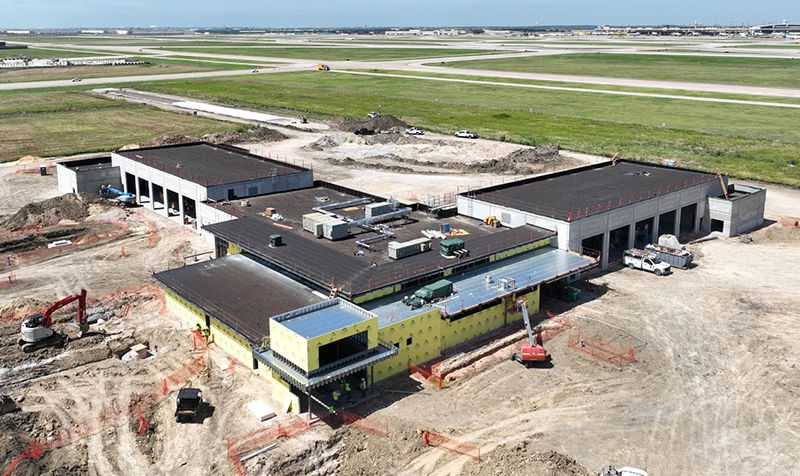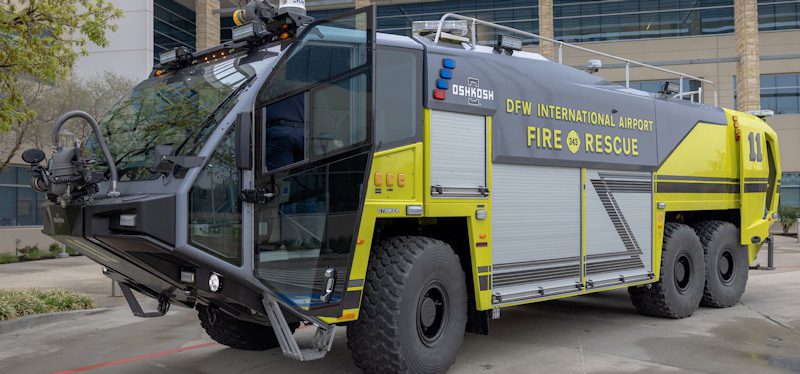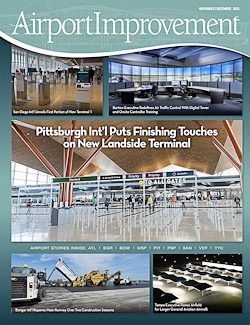Dallas Fort Worth International Airport (DFW), known throughout the industry for offering firefighting training to other airports and municipalities, is undertaking two major initiatives to further modernize and enhance its aircraft rescue and firefighting (ARFF) facilities and fleet. Together, the initiatives represent an investment of about $156 million.
While some of the changes represent significant achievements on the environmental front, department leaders emphasize the primary gains in response time and safety.
 facts&figures facts&figures
Projects: New ARFF Vehicles & Facilities Location: Dallas Fort Worth Int’l Airport Passenger Volume: 87.8 million in 2024 Vehicles New Fleet: 11 Striker® ARFF vehicles Cost: $26 million Vehicle Mix: 6 Striker® Volterra™ Hybrid Electric 6x6s; 5 diesel Striker ARFF vehicles (two 6x6s with 65-foot Snozzles®; two 4x4s with roof turret nozzle systems; one 4×4 with 50-foot Snozzle®) Vehicle Manufacturer: Oshkosh Airport Products Local Dealer: Siddons Martin Emergency Group Timeline: Entire fleet purchased in Sept. 2023; 1st hybrid delivered in June 2025, remaining 10 arrived by Aug. 2025 Key Benefits: Hybrid models have quicker acceleration, with reduced carbon emissions & noise; entire fleet uses fluorine-free foam to avoid PFAS exposure; consistent cab layout & controls throughout fleet for smooth transition from vehicle to vehicle for response crews Facilities Project: Fire Station Modernization Strategy: Replace 4 separate stations with 2 more modern facilities Component of: $12 billion DFW Forward capital Facility Size: 48,000 sq. ft. each Cost: $130 million Funding: $76 million FAA grant; $5 million via 2022 Federal Appropriations Act; airport capital improvement funds Architect: PGAL General Contractor: JE Dunn Slated for Operation: 2026 Key Benefits: Faster response to fires & other airfield incidents; charging infrastructure for new electric hybrid ARFF vehicles |
On the equipment front, the airport recently replaced all eight of its diesel ARFF vehicles with 11 new vehicles—six electric hybrids and five diesels—that all will only use fluorine-free foam. This June, DFW became one of the first airports in the United States to deploy electric hybrid ARFF technology when its Fire-Rescue Department took delivery of a Striker® Volterra™ Hybrid Electric. True to the department’s mission of prioritizing response and safety, the new 6×6 accelerates from 0 to 50 mph in less than 25 seconds— 28% faster than the diesel version of the equivalent vehicle. Subsequent deliveries of other Global Strikers followed, and the final two vehicles arrived in August.
On the facilities front, DFW is in the process of consolidating fire and rescue operations currently housed in four separate locations into two more modern stations that are now under construction and expected to be operational next year.
The recent fleet and ongoing facilities projects both have many elements, but one clear priority. “What it all boils down to is performance,” says DFW Fire Department Chief Dan White. “It’s performance first, under all circumstances. Everything else is icing on the cake.”
The airport makes decisions about technology and resources based on years of experience, he adds “Everything here starts with ‘safe and secure’ to select the best possible tools and training to perform at the highest possible level when called for.”
New Stations
The infrastructure changes have been unfolding for some time. The two new ARFF stations, each with 48,000 square feet of space, were included in the airport’s master plan that was approved in 2017 and updated in 2020. The $130 million project currently underway is replacing DFW’s four 50-year-old stations with two new stations, each with 48,000 square feet of space. Naturally, both will be equipped with charging systems for the new hybrid vehicles. Charging infrastructure will initially provide 240 volts, but will be capable of providing up to 480 volts depending on future needs such as more use or a larger fleet.
Project architect PGAL describes the new stations as a “critical” project for the airport.
The new East ARFF Station will replace existing stations 1 and 3; the new West ARFF Station will replace 2 and 4. White notes that there will be no changes in staffing or deployments, aside from existing firefighters working out of the new station locations.
Both new stations are expected to be operational next year, with demolition of the old facilities to follow. No plans have been announced regarding what DFW intends to use those land parcels for in the future.
For White, the bottom line is that the new stations will mean faster access to runways and taxiways. Amplifying that effect: faster new vehicles.
Innovative Fleet
As for the new Strikers, DFW had a bit of luck on its side because the airport’s existing diesels were reaching the end of their natural lifecycles just as the first electric hybrid Striker ARFF vehicles were coming on the market in 2023. At that time, the oldest ARFF vehicles in the airport’s fleet were from 2013, with others deployed in 2015. Also, the FAA approved fluorine-free foams for airports in 2023. “The timing was fortuitous for us,” White remarks. “We were going to replace this fleet no matter what, and the timelines aligned well.”
The airport bought 11 new ARFF vehicles in September 2023 for a total of $26 million. The entire fleet consists of various types of Global Strikers manufactured by Oshkosh Airport Products. Fully six of the new vehicles are cutting-edge electric hybrids.
The electric vehicle technology checks at least three boxes for airports, says Jack Bermingham, Business Unit director for Oshkosh Airport Products. The first is performance. Electric vehicles, such as the ones deployed at DFW, are faster to the scene and highly maneuverable, Bermingham points out. The new models also have various performance and cab design advantages, he adds.
The other two boxes: helping reduce the airport’s carbon footprint and reducing emissions and noise exposure for firefighters—with no performance degradation, Bermingham emphasizes. “Depending on duty cycle, training regimen and other factors, you can save 75% of diesel fuel [using hybrid technology], while generally adding to sustainability initiatives,” he advises.
The electric hybrids use battery power for the vast majority of their operation, but combine electric and diesel engine power when response crews need quick acceleration to speed to the scene of a fire or other incident. That battery-engine combination happens without additional input from the operator, Bermingham notes. In a similar vein, DFW’s new hybrids contain an auto-eject feature for the plug-in chargers that prevents overcharging and enables ARFF personnel to pull the vehicles out of stations as quickly as possible, without having to manually disconnect the chargers.

New foam is another major environmental and safety improvement. The airport’s entire fleet—hybrids and conventional diesels alike—dispense fluorine-free foams, therefore avoiding exposure to per- and polyfluoroalkyl or PFAS, the so-called forever chemicals.
Bermingham reports growing worldwide interest in electric ARFF vehicles, noting sales of Striker Volterras in 2023 to King County International-Boeing Field in Seattle, Western Sydney International Airport in Australia and Japan’s Air Self-Defense Force, as well as last year to Paris-Le Bourget Airport.
“We put a lot of emphasis on the user experience to make sure the operator doesn’t have to rethink how to operate an ARFF vehicle,” Bermingham explains. “The main operation of the vehicle is identical to our conventional vehicles.”
Even though DFW has varying models of Oshkosh’s Global Striker ARFF vehicles, the controls to operate them all are consistent, which helps operators move smoothly among various vehicles as needed. “The cab and compartment layout and configurations are the same,” Bermingham says.

Both new stations are expected to be operational in 2026.
Oshkosh and the local dealer, Global ARFF in Waxahachie, TX, conducted week-long training sessions on-site at DFW in April 2025 (before the vehicles were delivered).
Instruction on operating electric hybrid vehicles has not been added to the course selection at the well-known DFW Fire Training Research Center, which last year trained about 2,000 airport and municipal firefighters from around the world. However, one of the airport’s new conventional diesel ARFF vehicles is stationed at the center to help address the performance and application of fluorine-free foam.
Always Evolving
Change is rarely easy, yet DFW continues to forge ahead into new areas of ARFF response. Bermingham praises the airport, particularly White and his team, for re-thinking their strategy from a fleet and fire station perspective. In fact, he describes DFW as “a technological innovator and leader,” also noting that it has the single-largest fleet of electric ARFF vehicles in the world.
In terms of the new stations, White says that they are part of a broader, long-term plan. “We anticipate that eventually there will be another station added to the north [of the main terminal area],” he shares. No timeframe has been set for that project because it will depend on triggers such as passenger volume.
Other pending projects include construction of an airfield access bridge for the West Station and a new 2,600-square-foot fumigation facility, both designed by PGAL. The firm is also helping relocate a detention pond.
Whatever additional changes come, White emphasizes that the primary focus will remain the same. “We’re seeking a performance edge,” he explains. “And we have to do that in a safe, measured, calculated and responsible manner, knowing that we may be a reference point for the industry.”



